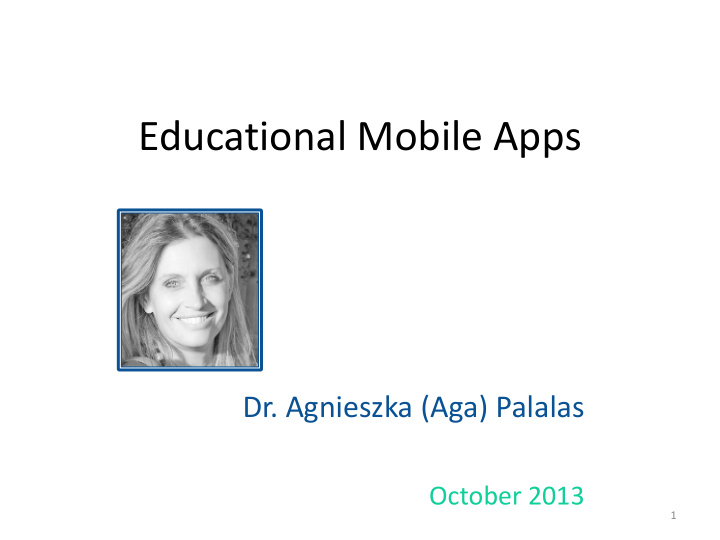



Educational Mobile Apps Dr. Agnieszka (Aga) Palalas October 2013 1
Educational Mobile Apps Outcome : To determine the key benefits and uses of mobile apps inside and outside the classroom. To identify the main issues to be considered when selecting or designing an educational app. 2
App Downloads Globally Free apps: 2012 - approximately 57.33 billion • 2013* - ~ 92.88 billion • 2017* - ~ 253.91 billion • Paid apps: 2012 - approximately 6.65 billion • 2013* - ~ 9.19 billion • 2017* - ~ 14.78 billion • 3
Number of Mobile Apps Used in Selected Asian Countries 2012 Number of apps used regularly ( median ) http://www.statista.com/statistics/233979/number-of-apps-used-by- Source: Nielsen, asiamediajournal.com asia-pacific-mobile-users/
http://www.statista.com/topics/1002/mobile-app-usage/chart/1474/global-app-downloads/ 5
Types of Educational Apps • In-class >> out-of-class • Formal >> informal • Synchronous >> asynchronous • Individual >> collaborative • Various degrees of transactional distance (Moore, 2007) … …contingent on needs and context Moore, M. G. (2007). The theory of transactional distance. In M. G. Moore (Ed.), Handbook of distance education (pp. 89-105). Mahwah, NJ: Lawrence Erlbaum Associates . 6
Types of Educational Apps • Access to resource (In-house mobile library) • Coordination (Twitter) • Communication (Skype, Facebook, SMS) • Collaboration (Google Apps) • Capturing and integrating data (camera) • Productivity (calendars, organizers, campus maps) • Built-in tools (GPS, voice recorder) 7
Mobile App Benefits 1/2 When designed properly, can offer all benefits of mobile learning PLUS • Gateway into e-learning tools • Stand-alone learning tools with specific purposes, goal-focused • Improved flexibility and convenience • User-control over content • Engagement 8
Mobile App Benefits 2/2 When designed properly, can offer all benefits of mobile learning PLUS • Affordability • Digitized resources (e-books, multimedia) • Gamification • Window into latest innovations (Augmented Reality) • Informal and lifelong learning 9
Assessing Apps Quality and learning value • General usability • Affordability • No common standards • Reviewers unable to keep up • 10
Educational App Assessment Criteria Educational value and curriculum connection • Engagement and interactivity • Authenticity • Feedback provision • User-friendliness and personalization • Progress monitoring tools • Security and privacy issues • 11
Other Issue to Consider • Purchasing vs. developing Apps • Native vs. web apps • Coding vs. app tools (PhoneGap) • HTML5 …contingent on needs and context 12
Mobile App Resources Chiong, C., & Shuler, C. (2010). Learning: Is there an app for • that? Investigations of young children’s usage and learning with mobile devices and apps. In New York: The Joan Ganz Cooney Center at Sesame Workshop. http://pbskids. org/read/files/cooney_learning_apps. pdf . Douglas, K. H., Wojcik, B. W., & Thompson, J. R. (2012). Is • There an App for that?. Journal of Special Education Technology , 27 (2), 59-70. Website to assist educators looking for mobile apps - • http://classroom-aid.com/technology-resources/educational-apps/ Example of language learning apps: http://slidesha.re/1hkI8px • 13
Thank you! Dr. Agnieszka Palalas aga@epluslearning.com LinkedIn: http://www.linkedin.com/in/apalalas Presentations: http://www.slideshare.net/agaiza Publications: http://athabascau.academia.edu/apalalas 14
Recommend
More recommend